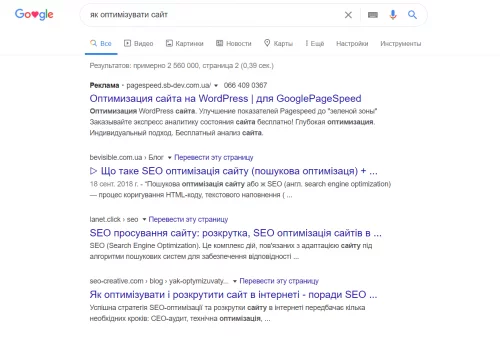This article will help you understand the basics of optimization and web positioning. It was written to provide answers to the most important questions, define the characteristics, and provide the basis of SEO.
SEO - definition and translation
SEO (Search Engine Optimization) is a literal translation of search engine optimization. This process reproduces a set of actions that help potential customers quickly find the right website in the Google search engine. Its goal is to build the trust of robots in the resource and achieve top positions in the the top positions in the search results.
When we enter the query "how to optimize a website" into a search engine, for example, Google, we get the following results.

В search engine has paid advertising - contextual advertising, as well as free search results (organic), and it is these results that depend on SEO.
SEO in the world
Most of companies in the world understand SEO only as processes related to building website visibility and getting traffic from search results (the so-called SERP, or Search Engine Result Page). SEO affects all factors, that improve rankings and visibility, not just optimization. This causes a lot of controversy.
The situation is similar with SEO and SEM, which are considered separately as: SEO - free search results and SEM - contextual advertising or more broadly - online advertising (Google Ads). So, SEM (Search Engine Markeitng) is usually a marketing activity consisting of all organic traffic and advertising.
What does SEO do?
In practice, as already mentioned, optimization consists of:
- text content (for example, when we change the length of articles, their titles, add keywords, etc.)
- website structure (a means of changing the navigation information architecture)
- technical and visual perception (website speed, responsiveness, appropriate choice of videos, moderate use of advertising, etc.)
- a link to the profile (i.e., as a rule, links lead to the site from other sites on the Internet).
Thus Thus, limiting yourself to SEO optimization code alone (sometimes including metadata and title) is simply a big mistake, because optimization is only a part of the of the whole.
In In practice, there are a lot of positioning factors. There are more than 200 of them, although none of them seem to have ever been used. It is difficult to do this because Google's algorithm is a mystery. Leading SEO efforts rely on Google's guidelines, our own experience, testing, and correlation analysis.

Off-pages on SEO pages
SEO factors can be divided into two categories - external (off-page) and internal (on-page). Individual factors also interact with each other, depending on the specific keywords with each other, depending on the specific keywords in terms of their importance and relevance.
The main groups of factors on the SEO page:
- content (mainly textual content, but not only that which is often created specifically for SEO text)
- architecture (i.e., the placement of content on the site, the connection between resources)
- HTML (creating a document structure: headings, paragraphs, lists, tables, quotes)
The main groups of factors outside of SEO pages:
- a link to your website
- social signals
- trust in the website (server, domain age, social media signals)
- other discussion issues.
Disputes around optimization and positioning
Many leading experts argue whether certain search engine factors really have an impact (in practice, mainly in the Google search engine), or whether they are just competing for high positions. It is quite difficult to verify this because we are always working in a changing environment. It's impossible to analyze it on a ceteris paribus basis. Along with the formation of one factor, change the others:
- link profile and optimization of competition pages
- Google algorithm
- user behavior.
This often leads to hasty and false claims. For example, many marketers at some point note that starting operations in Google AdWords increases traffic from organic results.
Optimizing content on the website
In today's technological world, website content is very important when optimizing for SEO. More and more often you can hear the opinion that the behavior of users on the Internet can also influence the site: how quickly it can be found, how much time you spend on it. These factors are directly related to the quality of the website content. Therefore, you need to fill the content of your pages with information that meets certain criteria.
What should be the text on web pages
Volumetric - Avoid short texts consisting of several paragraphs (advertising offers). Describe services and products in detail (their characteristics). The site reader will be able to learn a lot, and search engines will identify your page as more valuable.
Original - use of content that has not been copied from other sources (descriptions from other websites, descriptions from manufacturers, wholesalers). If you are not sure whether the text on the page is unique, you should use ready-made tools that will determine this.
According to the divided - in large texts, you should use H1, H2, H3 headings. These are HTML tags that help to define the structure of the text: heading/title (H1), subheading (H2), and others.
Contain relevant keywords and phrases. words - If you don't know how to choose the keywords that are best suited for your site, try using special tools. Use synonyms. This is a much better solution than keywords that are overly saturated with keywords, that are oversaturated with keywords.
Diverse - If the content on the site is just a block of text, you will not pay attention to it and will not want to read it. Use bold, italics, list markers. Try to find a suitable picture or graph.
Corresponding title tags
The title page is a very important element of SEO:
- This is one of the most important technical factors on the basis of which the search engine evaluates the subject of the page
- the page is displayed in the search results
- SEO optimization of the title meta tag and its impact on search results
- the page title is displayed in the search results

Optimizing the SEO headline that appears in the browser
Page title in the browser
How to to choose the best page titles? The title tag is definitely the place where you should place the keyword related to the content of the page, preferably at the very beginning. Due to the fact that page titles are displayed in the search results, we also have to enter our name there.
Results search results will display only the title of the page, which is no longer than approximately 55 characters (this is a guideline). In most cases, search results will display the page title that we set in the tag name, but there are cases where Google shows another title which it considers more appropriate. Another important issue is uniqueness.
Meta Description
This element is also directly linked to the HTML code of the page. This description is displayed in the search results, right below the title and URL of the page.
Content description, the purpose does not affect your site, but it is important for another reason. The content of the description that appears in search results can affect how people see our site in search results.
URLs
The URL should describe the content. In addition, users should also keep in mind the search engine crawlers that will crawl the site. For them, the best addresses are those that:
- not too long (up to about 100 characters)
- do not contain special characters, for example, "?", "$"
Examples of URLs:
http: //ujbg.en/index.php? cat = 2 & type = 14 & id = +141415155151513615155151 & sort? = price & filter? = price1000 - address is incorrect for SEO, because:
- it's too long
- contains special characters
- does not describe the content of the page well
http: //sjhgti.en/buty/zimowe/meskie/ - the address is correct for SEO, because because:
- it's short
- does not contain special characters
- is well aware of the content of the page.
Graphics.
On the page, you should pay attention to the large number of graphics. The longer your site takes to load, the more negatively it can affect SEO and prevent users from using it.
Tips for optimizing images
Alternative descriptions for images are elements associated with HTML graphics. It is displayed on the page instead of the image (in case of loading problems). В alternative description, we must indicate in a brief form what is in the picture. This way, the user knows what is in the image that is currently cannot be loaded. Images using alternative descriptions, is also important from an SEO point of view. Google cannot recognize them, but it can read the alternative descriptions.
Quantitative and qualitative factors in SEO activities
We often hear a misconception from partners and clients that SEO optimization is a one-time thing. Some website processes can be be improved and adapted to Google's requirements once. For example, it can be issues related to internal link errors (setting up redirects, 404 error), converting graphic links in menus to text links, page However, a lot of issues require constant long-term solutions, taking into account the intensity and pace of solutions, taking into account the intensity and pace of competition.
In order to To compete effectively in search results, you should create content optimized for different subjects and phrases, and form the structure of of the optimal one. In the case of links, not only the quantity but also the quality is taken into account. It is an indisputable fact that you need to work on it constantly.
SEO tools
Specialists. SEOs use a variety of tools to diagnose SEO optimization and There is no one perfect tool or set of tools that guarantees success. that guarantees success. First of all, each specialist has their own programs that help them. Secondly, even the best tools will not provide long-term success unless they are used by professionals who can read interpret the data and translate it into effective SEO optimization and and positioning tactics.
Among the popular tools used by agencies and SEO specialists are the following:
- Tools for link analysis: Ahrefs, Majestic, Link Research Tools, SEO Spyglass
- Software for visibility and position analysis: Senuto, Semstorm, SEMrush
- Support optimization modules: Yoast SEO (WordPress), Plug-in for sitemap creation or performance optimization (WP Super Cache)
- Elements of the Google ecosystem: Google Analytics, Google Trends, Google Insights
- Tools for analyzing correlation coefficients and research competition (e.g. SurferSEO)
SEO from a strategy perspective
In terms of strategic positioning and website optimization, they are:
- purchase traffic without a budget for each click
- presence in one of the most popular media, which is Google search,
- provides a point of contact between the brand and the customer when you are looking for information
This process should be viewed as part of the entire digital marketing strategy, not as a standalone activity. SEO is an ongoing process because search results for each phrase is a game, and the constant activities of competitors makes you work tirelessly and try to occupy high positions.
Communication between pages - advanced optimization
An important aspect of website optimization for SEO is the linking between pages. It is usually realized in the form of a menu that includes links to all the main sections. You should know that the best solution for SEO is to create a menu in in text form. Therefore, you should avoid menus created from images or using or flash technology (Google has trouble reading the full content of of such sites).
How can you check the optimization of SEO for your website?
В You can find a lot of browser plugins and programs on the Internet, that allow you to diagnose problems with website optimization and give suggestions on how to improve it. These tools are extremely necessary, as they can quickly make the appropriate changes.
SEO audit - what is it?
В In the context of SEO, the question often arises: what is an SEO audit? It should be note that the audit refers to both the analysis of technical, content and in the structure of the site, as well as external factors (link positioning) and website visibility at the time.
SEO audit includes analysis of website code, content analysis and keywords to reach potential customers, study of link profiles and analysis of competition in the Google search engine. All these actions are aimed at the long-term perspective to maintain the effectiveness of the website and links, as well as its placement in the first positions in the Google search network for potential customers' requests.









